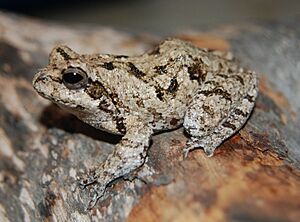Chiromantis kelleri facts for kids
Quick facts for kids Chiromantis kelleri |
|
|---|---|
 |
|
| C. kelleri in Oromia, Ethiopia | |
| Conservation status | |
| Scientific classification | |
| Synonyms | |
|
The Chiromantis kelleri is a type of frog. It belongs to the Rhacophoridae family, also known as the "moss frogs" or "tree frogs." This frog is often called Keller's foam-nest frog.
You can find this frog in parts of eastern and southern Ethiopia, northern Kenya, and Somalia. It might also live in South Sudan. The frog's scientific name, kelleri, honors a person named Conrad Keller. He was the one who first collected these frogs for study.
What Does It Look Like?
These frogs have different sizes depending on if they are male or female.
- Male frogs can grow up to 56 millimeters (about 2.2 inches) long.
- Female frogs are larger, reaching up to 92 millimeters (about 3.6 inches) long.
Their back usually looks rough. It is often grey and brown. Sometimes, it has darker spots or patterns. The throat of male frogs is grey. Their belly is a darker color. This frog's fingers and toes are partly webbed. They also have small, flat pads at the end of their digits. When a male frog calls out, it sounds like a slow, creaking noise.
Where Do They Live?
Chiromantis kelleri frogs live in dry areas. These places are often savannas or shrublands. A savanna is like a grassland with scattered trees. Shrublands have many bushes and shrubs.
These frogs breed in temporary pools of water. These pools only appear after it rains. They build special "foam nests" for their eggs. This foam protects the eggs.
How Are They Doing?
This frog is quite common. It is not considered a rare species. It can even live in very tough environments. However, its home could be at risk. People building new homes or farms can harm its habitat. More livestock (like cows or goats) can also damage the land. Even so, this frog seems to be good at adapting. It can adjust to changes in its environment.
The Chiromantis kelleri probably lives in some protected areas. For example, you might find them in Omo National Park and Mago National Park. Both of these parks are in southern Ethiopia.
See also
- Chiromantis petersii
- African foam-nest tree frog
- Grey foam-nest tree frog


